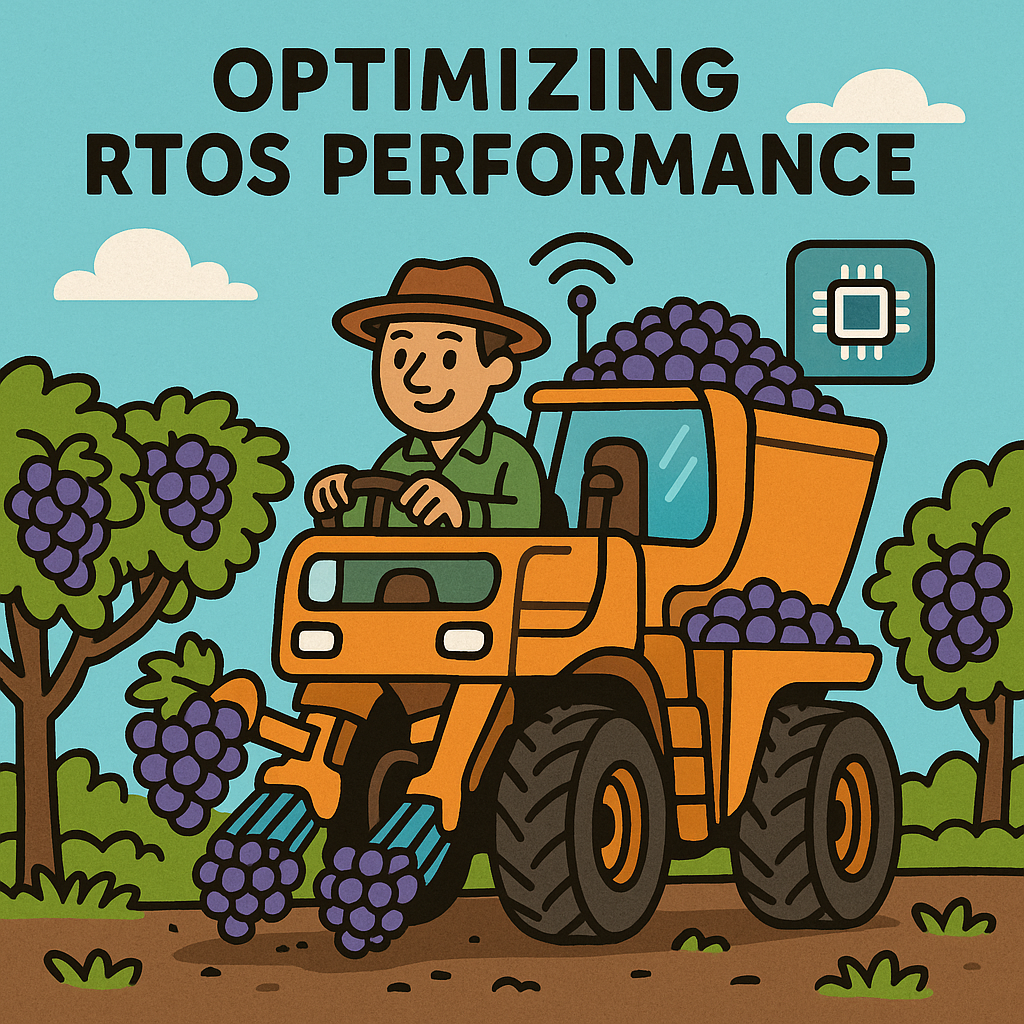Understanding the Role of RTOS in Autonomous Vineyard Harvesters
In the world of precision agriculture, autonomous vineyard harvesters are revolutionizing the way grapes are harvested. At the heart of these sophisticated machines lies a Real-Time Operating System (RTOS), which manages the hardware resources and ensures that tasks are executed in a timely manner. However, optimizing RTOS performance for embedded control units in these harvesters presents a unique set of challenges that engineers must navigate.
The Challenges of Real-Time Performance
When we consider the operational environment of a vineyard harvester, the challenges quickly multiply. These harvesters must operate in dynamic conditions, including varying terrain and unpredictable weather. The RTOS must manage multiple concurrent tasks, from steering and navigation to sensor data processing and actuator control. Each of these tasks has its own timing requirements, with some needing millisecond precision.
One of the primary challenges is ensuring that the RTOS can handle latency-sensitive tasks while also managing lower-priority operations without causing delays. This often leads engineers to grapple with the complexity of task scheduling and resource allocation. For instance, if the harvester’s navigation system lags, it could misinterpret its surroundings, leading to inefficiencies or damage to the vineyard.
Choosing the Right RTOS
The choice of RTOS is critical. Many engineers gravitate toward options like FreeRTOS, VxWorks, or QNX due to their proven track records in embedded systems. Each has its strengths; for example, FreeRTOS is lightweight and ideal for resource-constrained devices, while QNX offers advanced features for high-reliability applications. The decision often boils down to the specific requirements of the harvester.
For instance, if the harvester needs to process video feeds from cameras for obstacle detection, an RTOS with robust multimedia capabilities would be essential. Engineers must evaluate not just the performance characteristics but also the support for integrated development environments (IDEs), debugging tools, and community support, which can significantly impact development time and cost.
Firmware Optimization Techniques
Once the RTOS is selected, firmware optimization becomes the next hurdle. The goal here is to minimize the overhead introduced by the operating system. Techniques such as task prioritization and interrupt handling can significantly enhance performance. By prioritizing critical tasks, like sensor data acquisition, the system can maintain responsiveness even under heavy load.
Moreover, engineers often implement cooperative multitasking for less critical tasks, which allows the RTOS to yield control voluntarily. This approach can reduce context-switching overhead, thus improving overall system efficiency. Additionally, using direct memory access (DMA) can offload data transfer tasks from the CPU, freeing it up for more critical processing tasks.
Algorithm Design and Real-World Trade-offs
At the core of every successful RTOS implementation are the algorithms that govern the decision-making process. For autonomous vineyard harvesters, algorithms that handle path planning and obstacle avoidance are crucial. Engineers often employ techniques like Kalman filtering for sensor fusion, which improves the accuracy of the harvester’s perception of its environment.
However, the design of these algorithms is not without trade-offs. More complex algorithms may yield better accuracy and efficiency but can also introduce latency that could be detrimental in real-time applications. Engineers must find a balance between algorithm complexity and execution speed, often iterating through multiple designs to achieve the optimal solution. The use of model predictive control (MPC) has gained traction for its ability to optimize control actions over a defined time horizon, although it demands significant computational resources.
Integrating Sensors and Actuators
The integration of sensors and actuators is another critical aspect of optimizing RTOS performance. Autonomous harvesters rely on a myriad of sensors, from LIDAR for mapping to accelerometers for stability control. Each sensor must be carefully calibrated and synchronized within the RTOS to ensure accurate data collection and processing.
Additionally, actuators must respond swiftly to commands from the RTOS. This requires a well-designed feedback loop, where sensor data informs actuator position in real-time. Engineers often implement PID controllers for this purpose, but tuning these controllers can be a challenging task, especially in the dynamic environment of a vineyard.
Real-World Implementation: Lessons Learned
The journey of optimizing RTOS performance for autonomous vineyard harvesters is filled with lessons learned from the field. One such lesson is the importance of extensive testing under real-world conditions. Simulation tools can only take you so far; ultimately, the RTOS must prove its reliability in the unpredictable environment of a vineyard.
Moreover, developers often discover that maintaining a modular architecture allows for easier updates and improvements. As new sensors and algorithms are developed, they can be integrated into the existing system without overhauling the entire RTOS. This flexibility can significantly reduce time-to-market for new features and enhancements.
As we push the boundaries of technology in agriculture, the role of RTOS in autonomous vineyard harvesters will only grow in importance. Engineers will continue to refine their approaches, balancing performance, reliability, and innovation to meet the demands of modern farming. Each decision made in the design process shapes the future of how we harvest our crops, and ultimately, the flavors that reach our tables.



